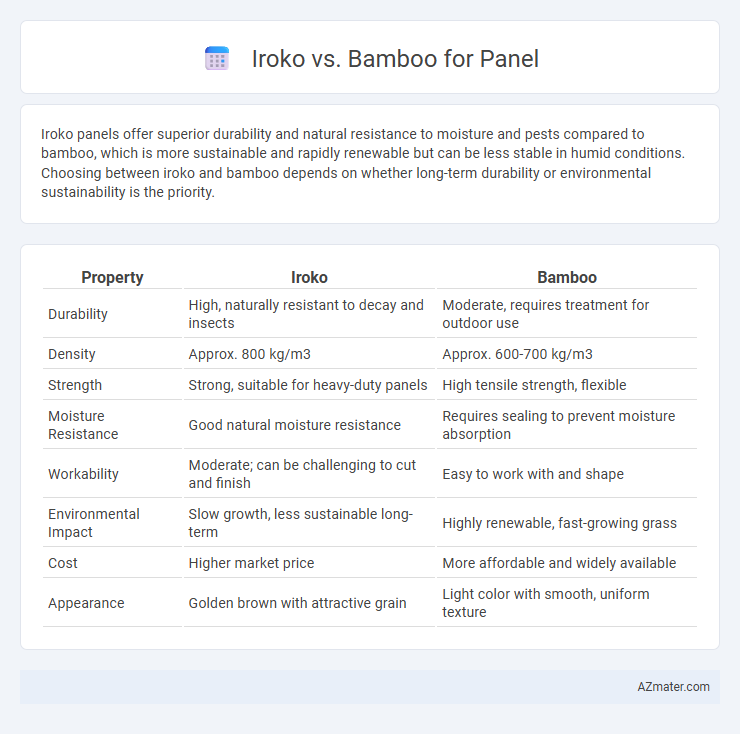Iroko panels offer superior durability and natural resistance to moisture and pests compared to bamboo, which is more sustainable and rapidly renewable but can be less stable in humid conditions. Choosing between iroko and bamboo depends on whether long-term durability or environmental sustainability is the priority.
Table of Comparison
| Property | Iroko | Bamboo |
|---|---|---|
| Durability | High, naturally resistant to decay and insects | Moderate, requires treatment for outdoor use |
| Density | Approx. 800 kg/m3 | Approx. 600-700 kg/m3 |
| Strength | Strong, suitable for heavy-duty panels | High tensile strength, flexible |
| Moisture Resistance | Good natural moisture resistance | Requires sealing to prevent moisture absorption |
| Workability | Moderate; can be challenging to cut and finish | Easy to work with and shape |
| Environmental Impact | Slow growth, less sustainable long-term | Highly renewable, fast-growing grass |
| Cost | Higher market price | More affordable and widely available |
| Appearance | Golden brown with attractive grain | Light color with smooth, uniform texture |
Introduction to Iroko and Bamboo Panels
Iroko panels exhibit high durability and natural resistance to moisture and insects, making them a popular choice for outdoor furniture and paneling projects. Bamboo panels offer exceptional sustainability due to their rapid growth rate and carbon sequestration properties, alongside a lightweight yet strong structure ideal for eco-friendly construction. Both materials provide unique aesthetic qualities, with Iroko showcasing rich golden-brown hues and bamboo featuring a distinctive linear grain pattern.
Environmental Impact: Iroko vs Bamboo
Iroko wood, sourced from slow-growing tropical trees, has a higher carbon footprint due to longer maturation periods and limited sustainability certifications compared to bamboo, which rapidly regenerates and is highly renewable. Bamboo panels absorb more CO2 during growth and contribute to soil stabilization, significantly reducing environmental degradation. Despite Iroko's durability, bamboo's lower environmental impact and faster growth make it a more eco-friendly choice for sustainable panel production.
Durability and Strength Comparison
Iroko wood exhibits superior durability and resistance to decay compared to bamboo, making it an excellent choice for long-lasting panels in outdoor and high-moisture environments. Bamboo offers impressive tensile strength but is more susceptible to insect damage and requires proper treatment to enhance its durability. For structural panels requiring robust strength and longevity, iroko provides a more reliable performance over time.
Aesthetic Appeal and Visual Differences
Iroko wood offers a rich, golden to dark brown hue with a coarse, interlocked grain that adds a natural warmth and striking character to panels, contrasting with bamboo's smooth, uniform surface and lighter, honey-toned color which provides a more contemporary and clean aesthetic. Panels made from Iroko present varied, natural patterns and richer color depth, giving spaces a luxurious and traditional feel, while bamboo panels showcase linear striations and a consistent texture, enhancing modern designs with a minimalist and eco-friendly appearance. The distinct visual differences between Iroko's dense, textured appeal and bamboo's sleek, pale finish influence design choices based on desired ambiance and style preferences.
Cost and Availability of Materials
Iroko wood is generally more expensive than bamboo due to its slower growth rate and limited availability, making it a premium choice for panels with a high-end finish. Bamboo is widely available and grows rapidly, resulting in lower costs and easier sourcing for large-scale panel production. Cost-effectiveness and material accessibility make bamboo a preferred option in eco-friendly and budget-conscious projects.
Installation and Workability
Iroko wood offers greater ease of installation due to its consistent density and resistance to splitting, allowing for smoother cutting and fastening in panel applications. Bamboo panels, while eco-friendly and lightweight, require more precision during installation because their fibrous structure can lead to splintering and uneven finishes if not handled carefully. Workability favors iroko for projects demanding durable fastening and shaping, whereas bamboo demands specialized tools and techniques to achieve optimal results.
Maintenance and Longevity
Iroko wood offers superior resistance to decay and insect attacks, making it a low-maintenance choice for panels that require long-term durability. Bamboo panels, while eco-friendly and rapidly renewable, demand regular sealing and moisture control to prevent warping and fungal growth over time. Both materials benefit from periodic treatment, but Iroko generally provides greater longevity with less intensive upkeep in outdoor or high-humidity environments.
Sustainability and Eco-Friendliness
Iroko wood, sourced from fast-growing African trees, offers durability with moderate sustainability due to its natural resistance to decay, making it a solid choice for eco-conscious paneling. Bamboo, known for its rapid renewability and carbon sequestration capabilities, surpasses many traditional woods in sustainability, as it regenerates within 3-5 years without replanting. Considering lifecycle impact and harvesting methods, bamboo panels typically present a lower environmental footprint than iroko, aligning closely with green building certifications and eco-friendly construction goals.
Common Applications for Iroko and Bamboo Panels
Iroko panels are commonly used in high-end furniture, cabinetry, and marine applications due to their durability, natural resistance to rot, and attractive grain. Bamboo panels are popular for flooring, wall paneling, and environmentally friendly furniture, valued for their rapid renewability and strength comparable to hardwood. Both materials offer unique aesthetic qualities, with Iroko providing rich golden hues and bamboo delivering a sleek, modern appearance suitable for sustainable design projects.
Choosing the Right Material: Iroko or Bamboo
Iroko offers exceptional durability and resistance to moisture, making it ideal for high-traffic or outdoor panel applications, while bamboo provides a sustainable, eco-friendly option with rapid renewability and a unique aesthetic appeal. Bamboo panels excel in lightweight strength and flexibility but may require additional treatment for water resistance compared to the naturally oily, rot-resistant Iroko wood. Selecting between Iroko and bamboo depends on balancing environmental impact, durability needs, and the desired look and feel of the panel installation.

Infographic: Iroko vs Bamboo for Panel
 azmater.com
azmater.com